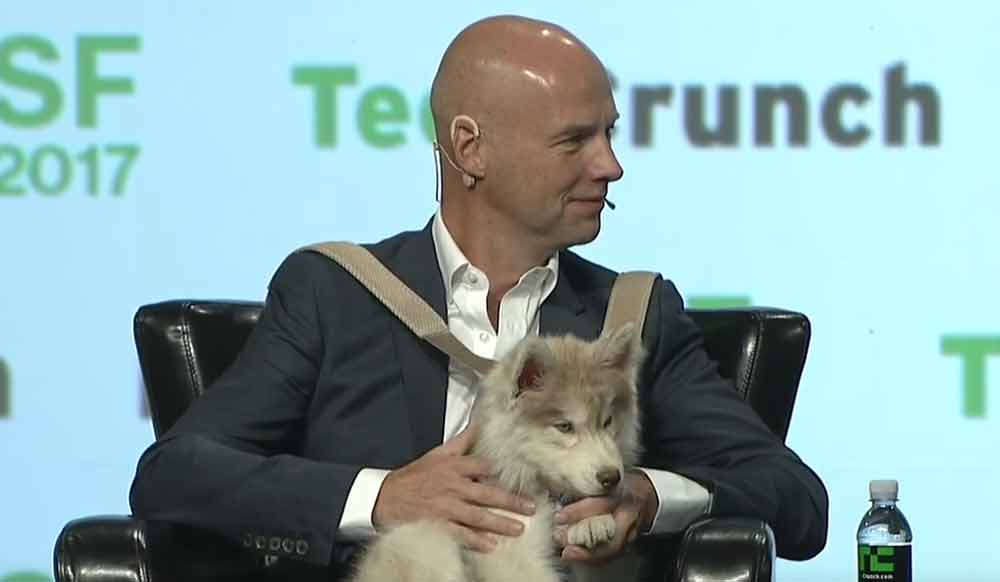
To many, Sebastian Thrun is known as the "Godfather of Self-Driving Cars," but he thinks that is a little overstated. "That's an exaggeration, there are so many people who deserve credit," Thrun said at the beginning of his on-stage interview at last year's TechCrunch Disrupt conference. Godfather or not, he also announced that his online education startup Udacity was launching a self-driving car engineering nanodegree program, which would at least secure him a spot on the Mount Rushmore of autonomous vehicle visionaries.
At this year’s Disrupt event, Thrun admitted that he thought maybe 20 people would be interested in the self-driving course. Instead, he told the audience, almost 50,000 people applied. The interest was so high that he announced Udacity’s new Intro to Self-Driving Cars nanodegree program on Tuesday.
Yet the Godfather of Self-Driving Cars is already looking beyond roads and into the sky. According to Thrun, the next "Next Big Thing" is the flying car. "It's completely crazy, no one in the world believes in it," he said. "But I believe it."
Thrun believes it so much that Udacity also launched a Flying Car Nanodegree Program on the same day, offering people all over the world the opportunity to be on the front line of what is possibly the future for both the automotive and aviation industries.
“There’s so much activity now in the drone space, that we just felt we should teach crazy sh-t, stuff no one else teaches, so that anyone who wants to have a job in this space is ready when the jobs come,” Thrun explained.
In addition to founding Udacity, Thrun is also the CEO of Kitty Hawk, which earlier this year showed off its entry into the "flying car" race, the Flyer. Of course, as many people pointed out, the Flyer is not a flying car. Not even close. Instead, it's like a jet ski that you can ride above water, or a "flying motorcycle," as Thrun elaborated on Tuesday. He expects the Flyer to be ready in February, and he called riding it the "funnest" experience of his life. "I've flown it and I'm still alive," he joked.
Other than what we know of the Flyer, Thrun said the company is operating “mostly in stealth mode,” before confirming that Kitty Hawk’s vision is far greater than just a flying motorcycle.
“Self-driving cars are very hot right now, but three years ago no one cared about them. Three years from now, flying cars will be very hot and they will disrupt the self-driving car. At Kitty Hawk, we’re trying to invent this.”
Thrun cited the effort of Amazon and other companies to make delivery drones a part of our daily routines. He understands that a lot of work needs to be done in putting "tens of thousands of things in the air at the same time," but he thinks it's ridiculous that people have accepted the frustrations of traffic jams when the sky is wide open.
“The vision of the company is that we should fly every day. There’s no reason why we should be stuck in traffic anymore when we can fly,” Thrun insisted. “The air is so free of stuff and is so unused compared to the ground… it has to happen, in my opinion.”
But what about Elon Musk’s insistence that the future of travel is not in the air, but instead underground? Thrun believes we should try everything, but what makes Musk’s Boring Company problematic is infrastructure costs. “Digging tunnels is expensive,” Thrun said.
“I’m not a fan of the California high-speed rail. I think it’s a big mistake for the state and country," he continued. "The reason is we have a phenomenally great mass transit system between Los Angeles and San Francisco called airplanes. They work very well, they’re more energy-efficient, they’re safer than rail, there’s no infrastructure required — I have no clue why we move backwards in this state as opposed to forward.”
One of the biggest advantages of flying cars and ride-sharing aviation, at least according to the companies pushing the concept, is that it would save everyone so much time. They also claim it won’t cost much more than most Uber or Lyft car trips. Thrun agrees and imagines a world in which anyone, and not just a Silicon Valley billionaire with a private jet, can go from Palo Alto to San Francisco in 10 minutes.
There are, of course, disadvantages and limitations, which is why it would seem that we're still a decade away from flying cars (if they ever arrive at all). Not true, said Thrun. He believes we're two years away. He's nothing if not ambitious, as evident by his Tomorrowland dreaming.
“I love thinking about the world as a playground where almost anything interesting has not been invented yet. If I ask myself how we will look in the future, I can’t envision a future where we still have highways stuffed with cars. I envision a future where you hop on your thing, you go in the air, fly somewhere in a straight line, and you’re safer than on the ground. You’re faster, you’re cheaper. I envision a future where Amazon delivers my food through the air within five minutes, from the restaurant to maybe my dining table.”
That begs the question of what happens to all of the jobs Thrun’s future would eliminate, but maybe that will be part of Udacity’s 2018 announcement.

Sign-up for newsletters & special offers!
Get the latest FLYING stories & special offers delivered directly to your inbox






